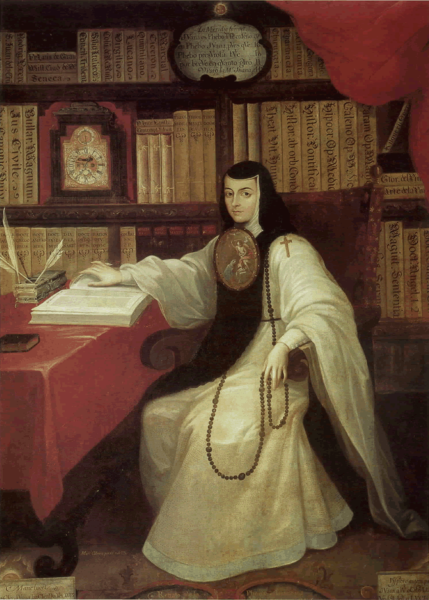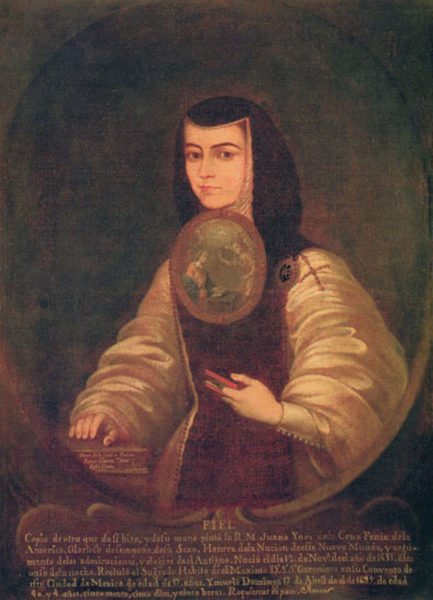 Sor Juana Inés de la Cruz (1648-1695) is regarded as one of the most prominent authors of Spanish literature and the foremost Baroque poet in seventeenth-century colonial Mexico (New Spain.) She was born in San Miguel Nepantla, the illegitimate daughter of Spanish Captain Pedro Manuel de Asbaje and a criolla (mixed race) woman, Isabel Ramírez. She learned to read at a young age, devouring her maternal grandfather’s books and showing signs of being an exceptionally intelligent child. At the age of 12, Sor Juana was sent to Mexico City, where she became a lady-in-waiting at the court of the Viceroy Antonio Sebastián de Toledo. She was tutored by Vicereine Leonor Carreto, and astonished the court with her extensive knowledge of philosophy, theology, science, and poetry.
Sor Juana Inés de la Cruz (1648-1695) is regarded as one of the most prominent authors of Spanish literature and the foremost Baroque poet in seventeenth-century colonial Mexico (New Spain.) She was born in San Miguel Nepantla, the illegitimate daughter of Spanish Captain Pedro Manuel de Asbaje and a criolla (mixed race) woman, Isabel Ramírez. She learned to read at a young age, devouring her maternal grandfather’s books and showing signs of being an exceptionally intelligent child. At the age of 12, Sor Juana was sent to Mexico City, where she became a lady-in-waiting at the court of the Viceroy Antonio Sebastián de Toledo. She was tutored by Vicereine Leonor Carreto, and astonished the court with her extensive knowledge of philosophy, theology, science, and poetry.
It is unclear exactly why she left the court, but in 1669, she entered religious life and became a Carmelite postulant at the Monastery of St. Joseph. After a short period of time, she moved to the Convent of Santa Paula of the order of San Jerónimo, which was less strict and gave her more time “to have no fixed occupation which might curtail [her] freedom to study.” She remained cloistered there under the patronage of the Viceroy and other benefactors, who supported her and arranged to have her writings published in Spain. Sor Juana was at the forefront of the intellectual life of the times, pursuing her academic interests and writing letters, song lyrics, poems, plays, and a theological essay.
Her studies and writing were very productive in the years after she became a nun, and her influence was manifested by the many commissions she received. In 1680, she fulfilled one especially significant commission, writing a poem to celebrate the building of a triumphal arch that was added to the cathedral after the appointment of a new Viceroy. In the poem, “Allegorical Neptune,” she was outspoken about her feminism and put forward the defiant idea that male power depended on female wisdom. Many researchers consider her masterpiece to be her 1685 poem, “Primero Sueño,” which consists of 975 lines written in the free Italian form, called silvas in Spanish. She was also fluent in the Aztec language, Nahuatl, and during her lifetime was sometimes referred to as “The Tenth Muse” or “The Mexican Phoenix.”
productive in the years after she became a nun, and her influence was manifested by the many commissions she received. In 1680, she fulfilled one especially significant commission, writing a poem to celebrate the building of a triumphal arch that was added to the cathedral after the appointment of a new Viceroy. In the poem, “Allegorical Neptune,” she was outspoken about her feminism and put forward the defiant idea that male power depended on female wisdom. Many researchers consider her masterpiece to be her 1685 poem, “Primero Sueño,” which consists of 975 lines written in the free Italian form, called silvas in Spanish. She was also fluent in the Aztec language, Nahuatl, and during her lifetime was sometimes referred to as “The Tenth Muse” or “The Mexican Phoenix.”
Moving into the 1690s, Sor Juana was frequently at odds with her superiors and church authorities. Nevertheless, in 1691, she waded into church politics and wrote a theological critique of a 40-year old sermon of a well-regarded Portuguese Jesuit, Father Antonio de Vieyra. Using the pseudonym of Sor Filotea de la Cruz, the bishop of Puebla, Manuel Fernández de Santa Cruz published her critique without her permission and sent her a letter, denouncing her for her emphasis on secular rather than religious scholarship.
In her letter of response, La Respuesta a Sor Filotea de la Cruz, Sor Juana defended her interest in academic life and advocated for the educational rights of women to study and write and teach. It is likely that she knew when she wrote the letter that she would be required to give up her intellectual pursuits and undertake a life of silence and physical penance. She was, in fact, sharply disciplined and forced to sell her extensive library and her collection of musical instruments and scientific equipment. And so indeed, Sor Juana was effectively silenced. Near the end of her life, she cared for other nuns who became victims of a devastating plague and, finally contracting the disease herself, she died in 1695 at the age of forty-six.
 I was very surprised and excited to find out that there was such an incredible and learned seventeenth-century female scholar in the Americas. Below is the quote that I have chosen to include in my book and at the left is the acrylic monoprint that I made to go with it. It is an excerpt from La Respuesta a Sor Filotea de la Cruz.
I was very surprised and excited to find out that there was such an incredible and learned seventeenth-century female scholar in the Americas. Below is the quote that I have chosen to include in my book and at the left is the acrylic monoprint that I made to go with it. It is an excerpt from La Respuesta a Sor Filotea de la Cruz.
Porque si miramos su presencia, ¿cuál prenda más amable que aquella Divina Hermosura? ¿Cuál mas poderosa para arrebatar los corazones? Si cualquiera belleza humana tiene jurisdicción sobre los albedríos y con blanda y apetecida violencia los sabe sujetar, ¿qué haría aquella con tantas prerrogativas y dotes soberanos? ¿Qué haría, qué movería y qué no haría y qué no movería aquella incomprensible beldad, por cuyo hermoso rostro, como por un terso cristal, se estaban transparentando los rayos de la Divinidad? ¿Qué no movería aquel semblante, que sobre incomparables perfecciones en lo humano señalaba iluminaciones de Divino?
Because if we look at [Christ’s] presence, what promise is more to be loved than that Divine Beauty? What is more powerful to stir our hearts? If human beauty has jurisdiction over capriciousness, and knows how to subdue it with both tenderness and ravenous intensity, what power would Divine Beauty exert, with so many prerogatives and sovereign endowments? What would such incomprehensible beauty do and move, or not do and not move, that lovely face, transparent like a brilliant crystal, through which the rays of Divinity were shining? What would not be moved by that face that is incomparably above human perfections and that was revealed by illuminations of the Divine?
Sor Juana Inés de la Cruz (1648-1695)
The translation from the Baroque style Spanish is mine, with a little help from my friend Andrea. I especially like the comparison of Christ’s face to a crystal, with the rays of Divine Light shining through. It reminds me of my January 28, 2017 blog post, where I described my kaleidoscope artwork, in which God was the light that was shining through and dancing with the colored glass pieces of my life.
Reference: Sor Juana Inés de la Cruz, Sayers Peden, Margret, ed., “Poems, Protest and a Dream,” Penguin Books, New York, NY, 1997.
Image 1: Portrait of Sor Juana by Miguel Mateo Maldonado y Cabrera (1695-1768.)
Image 2: Portrait of Sor Juana by Friar Miguel de Herrera (1700-1789.)
Image 3: “Sor Juana Inés de la Cruz,” Julie Henkener, 2017.















2 Comments
Leave your reply.